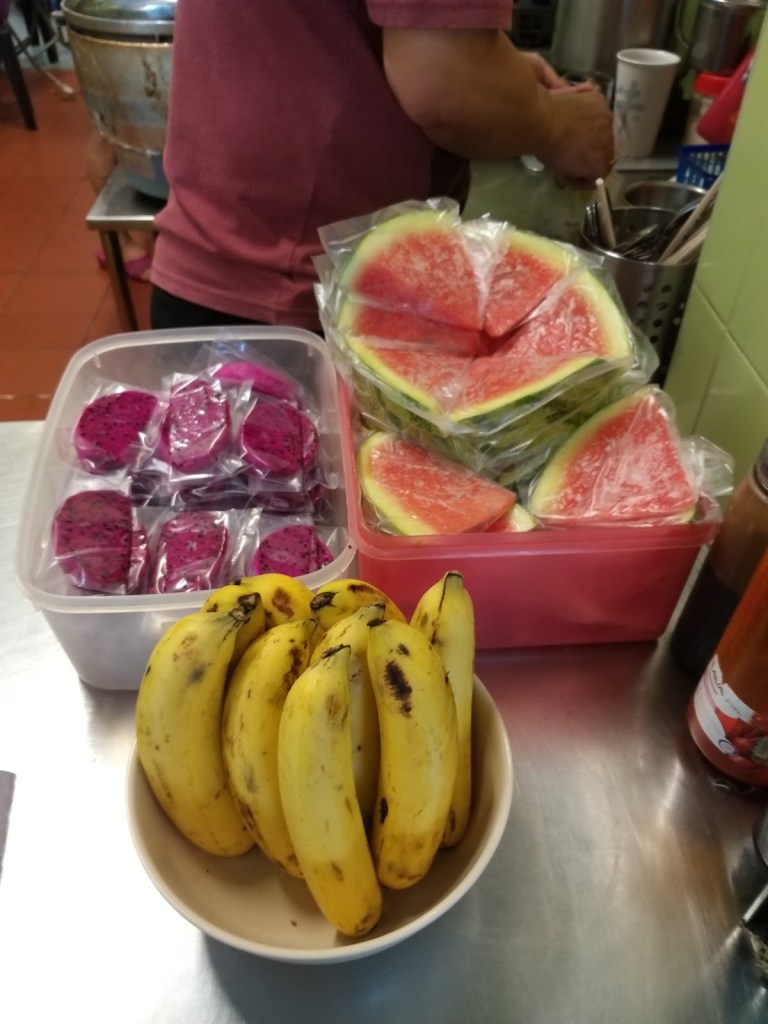By Tay Jing Xuan (20S03C)
Take a look at Singapore’s—no, the world’s daily food waste, and you’ll notice a very unsettling trend.
Roughly 1.3 billion tonnes of food is wasted every year globally. That’s about 3.6 million tonnes wasted daily. By now, one should know pretty well the impact food waste has on the environment and the jarring imbalance of food across the world, with millions starving while developed countries choke on superfluity. Yet, the numbers are only climbing, with the increase of mouths to feed leading to even greater excess being produced.
But that’s the world. What about the canteen in Raffles Institution?
Right now, the most wasted food are vegetables and fruits. Both stall owners and customers are only keen on the freshest, most vibrant produce, which means even the tiniest of blemishes deem a vegetable or fruit unmarketable. However, in our canteen, the most prominent issue of fruit (and food) waste stems from the unwillingness of students to eat the fruits. What does this translate into? That’s right—into the bin it all goes.

Fortunately, quite a number of canteen vendors are aware of this problem. Ever since the Healthy Meals in Schools Programme was implemented, all stalls were mandated to give out fruits along with their food. However, there are bound to be fruits left over, right? Not really. Tan’s Chinese Cooked Food stall gives out a wide variety of fruits, from dragon fruit slices and bananas to watermelon and longan, but they often run out by the end of the day. If they do have leftovers, they give it out to passing students right before they close.

An interview with Auntie Aminah of her Nasi Padang stall reveals the whereabouts of uneaten fruit. When asked what happened to fruits left over, she laughed and said, “Almost none are left over!” while pulling down a box that contained a few small bananas, which “will be taken home for [her family] to eat”. In some ways, the Healthy Meals in Schools Programme extends to the family of canteen vendors as well.
Ms Janmuangmoon and Mr Lee Chiap Kau, the owners of the fruit stall, say that instead of throwing away their leftover fruits—some ready to blossom into over-ripeness at any given moment—they blend it into smoothies and juices for the cleaners and maintenance workers visiting the school. They give cut fruits out to students lingering in the canteen, and to prevent fruit wastage they stop cutting up their fruits by 1pm, so they can be kept for sale over the next few days.

And the overall food waste situation in the school? The canteen vendors have a solution.
According to Mr Lee, food waste doesn’t just affect the environment—it takes a toll on the stallowners’ finances as well. So, with their decades of experience and keen eyes, they get to work portioning and preparing only what they feel will be needed for the morning, before the afternoon rush sets in. And even if the queues get unexpectedly long (perhaps owing to the difference in taste between old and new batches of students), they will delegate the sales and cooking to different staff, and get to work satisfying everyone’s needs while keeping to their budget.

During the interview with Mr Lee, he mentioned that “different prices for different portions of dishes, especially for zhap cai png (mixed rice) stalls, might help”. In the end, however, he acknowledged the trouble every stall would have to go through to process each order should the system be put in place. Evidently, the efforts of the canteen vendors have truly helped prevent food waste in RI, and it would be unreasonable of us to add such inconvenience to their work.
Well, as every good Economics student knows, at equilibrium, supply equals demand. As every good student also knows, the efforts of the canteen vendors aren’t enough to combat food and fruit waste. What can we do then, as students?
As Mr Lee so aptly put it, “if you don’t like it, then don’t buy (it)”. Did you know you can request for the fruit to be taken off your tab if you don’t intend to take the fruit? This leaves more fruit for students who are willing to eat them, and it leaves less fruit in the trash cans after each meal. As for the food, buy only what you can eat and not based on how hungry you think you are. After all, that extra fried fish you couldn’t manage could have gone to another hungry student’s plate.

If you really can’t finish your fruit, give it to someone who will. This is a good one for the moment—your fruit-loving friend gets extra dessert, and you get to reduce waste. But in the long run, you can’t just push your fruit or leftover food to your colleagues to finish up. So the best solution really is to just portion your food and bite off only what you can chew (literally).

Now, what can we do to spread the word about food waste?
Some of us might go grocery shopping with our family, or at the very least help them carry their bags into the house. What we can do to help reduce the waste we generate at home is to initiate a conversation about food waste, encourage them to make more frequent trips to the nearest Fairprice, remind them to buy only what they need. Buying in bulk may be tempting, with discounts for big bags of biscuits. But you know how food waste might be generated from such shopping practices—that is how you can be a big source of influence. So whether your family goes to the supermarket or order groceries online, make sure to remind them about the consequences of food waste and how they may take steps to reduce it.
So where does the fruit go? From now on, we can work towards turning the answer from “the bins” to “our own consumption”.

